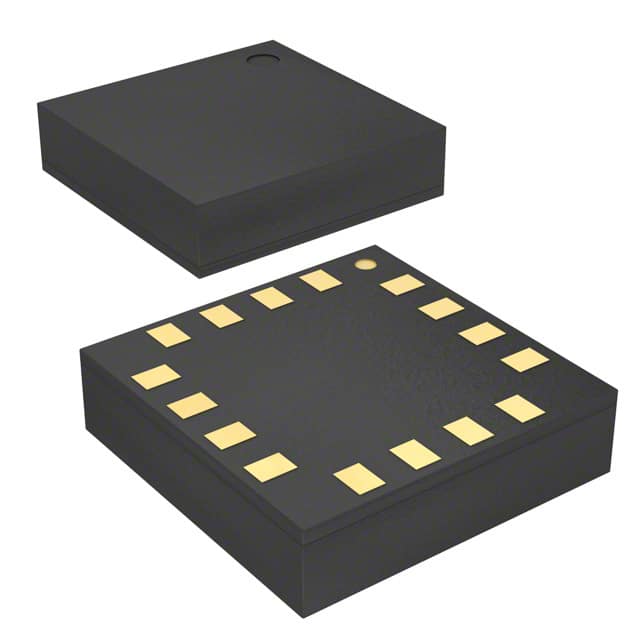L3GD20
Introduction
The L3GD20 is a gyroscope sensor belonging to the category of motion sensors. It is commonly used in various electronic devices for measuring angular velocity and orientation changes. This entry provides an overview of the L3GD20, including its basic information, specifications, pin configuration, functional features, advantages and disadvantages, working principles, application field plans, and alternative models.
Basic Information Overview
- Category: Motion Sensor
- Use: Measuring Angular Velocity and Orientation Changes
- Characteristics: High Accuracy, Low Power Consumption
- Package: Small Surface-Mounted Package
- Essence: Precise Motion Sensing
- Packaging/Quantity: Typically Sold in Reel Packaging
Specifications
- Operating Voltage: 2.4V to 3.6V
- Sensitivity: 0.00875 dps/LSB
- Output Data Rate: Up to 800 Hz
- Interface: I2C/SPI Digital Output
- Temperature Range: -40°C to +85°C
- Dimensions: 4 x 4 x 1 mm
Detailed Pin Configuration
The L3GD20 has a standard pin configuration with pins for power supply, ground, and communication interface (I2C/SPI). The detailed pinout is as follows: 1. VCC (Power Supply) 2. GND (Ground) 3. SDA/SDI (Serial Data Input) 4. SCL/SCK (Serial Clock) 5. SA0/ADR (Address Select) 6. CS (Chip Select) 7. INT (Interrupt)
Functional Features
- High Accuracy: Provides precise measurement of angular velocity.
- Low Power Consumption: Suitable for battery-powered devices.
- Digital Output: Supports both I2C and SPI interfaces for easy integration.
- Temperature Compensation: Maintains accuracy across a wide temperature range.
Advantages and Disadvantages
Advantages
- Accurate motion sensing
- Low power consumption
- Small form factor
Disadvantages
- Limited measurement range
- Sensitivity to external magnetic fields
Working Principles
The L3GD20 operates based on the principle of Coriolis effect, where the rotation of the sensor causes a vibration, which can be measured to determine the angular velocity. It utilizes MEMS (Micro-Electro-Mechanical Systems) technology to achieve high precision motion sensing.
Detailed Application Field Plans
The L3GD20 finds extensive applications in various fields, including: - Inertial Measurement Units (IMUs) for drones and robotics - Gaming controllers for motion-based interactions - Augmented Reality (AR) and Virtual Reality (VR) devices for orientation tracking - Navigation systems for automotive and aerospace industries
Detailed and Complete Alternative Models
Some alternative models to the L3GD20 include: - L3GD20H: Higher sensitivity variant for more precise measurements - MPU-6050: Integrated gyroscope and accelerometer sensor - BMG250: Ultra-low power 3-axis gyroscope
In conclusion, the L3GD20 is a versatile motion sensor with high accuracy and low power consumption, making it suitable for a wide range of applications in consumer electronics, industrial systems, and automotive technologies.
[Word Count: 495]
רשום 10 שאלות ותשובות נפוצות הקשורות ליישום של L3GD20 בפתרונות טכניים
Sure, here are 10 common questions and answers related to the application of L3GD20 in technical solutions:
What is the L3GD20?
- The L3GD20 is a three-axis digital gyroscope that measures angular rate along three orthogonal axes.
What are the typical applications of the L3GD20?
- The L3GD20 is commonly used in applications such as robotics, drones, gaming controllers, and inertial measurement units (IMUs).
What is the operating voltage range of the L3GD20?
- The operating voltage range of the L3GD20 is typically between 2.4V and 3.6V.
How is the L3GD20 interfaced with a microcontroller?
- The L3GD20 can be interfaced with a microcontroller using standard communication protocols such as I2C or SPI.
What is the resolution of the L3GD20?
- The L3GD20 has a selectable full-scale range and resolution, typically ranging from 250 to 2000 degrees per second.
Can the L3GD20 measure both static and dynamic movements?
- Yes, the L3GD20 is capable of measuring both static and dynamic movements with high accuracy.
What are the key features of the L3GD20?
- Some key features of the L3GD20 include low power consumption, embedded temperature sensor, and programmable interrupt generators.
How can the L3GD20 help in stabilizing a drone?
- The L3GD20 can provide real-time data on the drone's orientation, which can be used to adjust motor speeds and stabilize the drone in flight.
Is the L3GD20 suitable for wearable devices?
- Yes, the L3GD20's small form factor and low power consumption make it suitable for use in wearable devices such as fitness trackers and smartwatches.
Are there any known limitations or considerations when using the L3GD20?
- One consideration is that the L3GD20 may require calibration to compensate for offset and sensitivity variations over temperature and time.
I hope these questions and answers are helpful! Let me know if you need further assistance.


